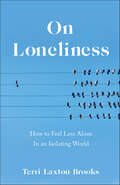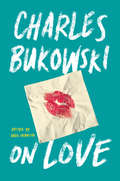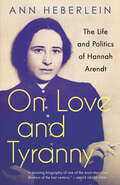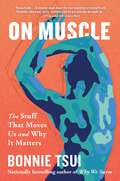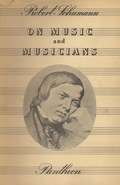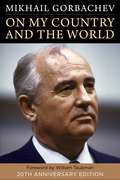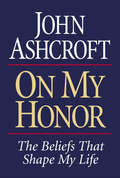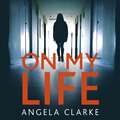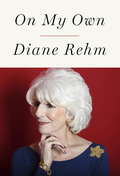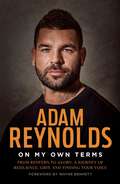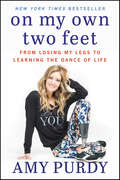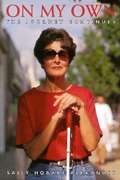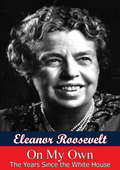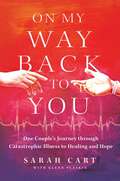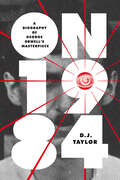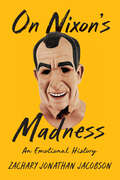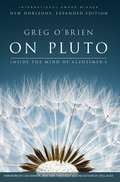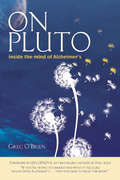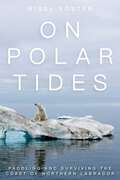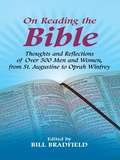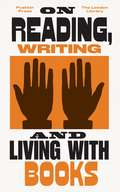- Table View
- List View
On Loneliness: How to Feel Less Alone In an Isolating World
by Terri Laxton BrooksIn this no-holds-barred, provocative book, Terri Laxton Brooks tells a story that often remains hidden— that of a successful professional who has many friends and family and yet all her life has struggled with a loneliness she’s never revealed to anyone. Terri thinks her feelings of isolation will end with her marriage to her childhood sweetheart and their move from a farm town to the city of Chicago. But once the sheen of newlywed passion wears off, her husband, by nature reticent, grows even more emotionally distant. In her new job as a reporter for a Chicago paper, Terri hides her loneliness under a flurry of bylines and deadlines. But she can’t shake a feeling she’s had since childhood—of failure to connect, not just as a wife but also as a daughter, friend, and colleague—and soon she and her husband separate. Adrift, Terri contemplates suicide. Could a move to different city, to a fresh start, solve her problem? Terri’s decision to transplant herself to New York City forces her hand in a way she never imagined: it plunges her into a loneliness so total that out of desperation she grabs the key to her own salvation— ; love of interviewing, researching, hearing people’s stories. After starting therapy, her curiosity leads her into four years of soul-searching conversations with America’s leading psychologists and psychiatrists about how to cope with loneliness, why it is a normal and necessary stage of healthy growth, and how to stop resisting it. She explores with growing understanding intimate details of her dreams, her past traumas, and her role in her own loneliness—and learns not only how to live comfortably with that loneliness but how to use it to her advantage.
On Love
by Charles BukowskiA raw and tender poetry collection that captures the dirty old man of American letters at his fiercest and most vulnerable, on a subject that hits home with all of us.<P><P>Charles Bukowski was a man of intense emotions, someone an editor once called a "passionate madman." In On Love, we see Bukowski reckoning with the complications and exaltations of love, lust, and desire. Alternating between tough and gentle, sensitive and gritty, Bukowski lays bare the myriad facets of love--its selfishness and its narcissism, its randomness, its mystery and its misery, and, ultimately, its true joyfulness, endurance, and redemptive power.Bukowski is brilliant on love--often amusing, sometimes playful, and fleetingly sweet. On Love offers deep insight into Bukowski the man and the artist; whether writing about his daughter, his lover, his friends, or his work, he is piercingly honest and poignantly reflective, using love as a prism to see the world in all its beauty and cruelty, and his own fragile place in it. "My love is a hummingbird sitting that quiet moment on the bough," he writes, "as the same cat crouches."Brutally honest, flecked with humor and pathos, On Love reveals Bukowski at his most candid and affecting.
On Love and Tyranny: The Life and Politics of Hannah Arendt
by Dr. Ann HeberleinIn an utterly unique approach to biography, On Love and Tyranny traces the life and work of the iconic German Jewish intellectual Hannah Arendt, whose political philosophy and understandings of evil, totalitarianism, love, and exile prove essential amid the rise of the refugee crisis and authoritarian regimes around the world. What can we learn from the iconic political thinker Hannah Arendt? Well, the short answer may be: to love the world so much that we think change is possible.The life of Hannah Arendt spans a crucial chapter in the history of the Western world, a period that witnessed the rise of the Nazi regime and the crises of the Cold War, a time when our ideas about humanity and its value, its guilt and responsibility, were formulated. Arendt’s thinking is intimately entwined with her life and the concrete experiences she drew from her encounters with evil, but also from love, exile, statelessness, and longing. This strikingly original work moves from political themes that wholly consume us today, such as the ways in which democracies can so easily become totalitarian states; to the deeply personal, in intimate recollections of Arendt’s famous lovers and friends, including Heidegger, Benjamin, de Beauvoir, and Sartre; and to wider moral deconstructions of what it means to be human and what it means to be humane.On Love and Tyranny brings to life a Hannah Arendt for our days, a timeless intellectual whose investigations into the nature of evil and of love are eerily and urgently relevant half a century later.
On Marx and Engels
by V. I. LeninThis book is a brief biographical sketch with an exposition on Marxism.
On Muscle: The Stuff That Moves Us and Why It Matters
by Bonnie TsuiFrom the bestselling author of Why We Swim comes a mind-expanding exploration of muscle that will change the way you think about what moves us through the world. &“Remarkable . . . A singular book about the true meanings of strength and flexibility, about our ability to define who we are and who we might be.&” —Ed Yong, New York Times bestselling author of An Immense World and I Contain Multitudes In On Muscle, Bonnie Tsui brings her signature blend of science, culture, immersive reporting, and personal narrative to examine not just what muscles are but what they mean to us. Cardiac, smooth, skeletal—these three different types of muscle in our bodies make our hearts beat; push food through our intestines, blood through our vessels, babies out the uterus; attach to our bones and allow for motion. Tsui also traces how muscles have defined beauty—and how they have distorted it—through the ages, and how they play an essential role in our physical and mental health. Tsui introduces us to the first female weightlifter to pick up the famed Scottish Dinnie Stones, then takes us on a 50-mile run through the Nevada desert that follows the path of escape from a Native boarding school—and gives the concept of endurance new meaning. She travels to Oslo, where cutting-edge research reveals how muscles help us bounce back after injury and illness, an important aspect of longevity. She jumps into the action with a historic Double Dutch club in Washington, D.C., to explain anew what Charles Darwin meant by the brain-body connection. Woven throughout are stories of Tsui&’s childhood with her Chinese immigrant artist dad—a black belt in karate—who schools her from a young age in a kind of quirky, in-house Muscle Academy. On Muscle shows us the poetry in the physical, and the surprising ways muscle can reveal what we&’re capable of.
On Music and Musicians
by Robert SchumannEdited by Konraad WolffTranslated by Paul RosenfeldWith twenty black-and-white illustrationsSchumann&’s literary gifts and interests almost equaled his musical ones. From boyhood on he was drawn to literary expression, and his writings on music belong to the best among the romantic literature of the 19th century. The same fire, poetry, directness of expression, the same inventiveness we love in his compositions, also animated his prose.This edition for the first time groups his articles and observations according to subject matter and individual composers. It is complete as far as Schumann&’s writings on the great composers are concerned. All his reviews of the works by the masters, from Beethoven to Brahms, are included, some of them translated for the first time into English.
On My Country and the World: On My Country And The World
by Mikhail GorbachevHere is the whole sweep of the Soviet experiment and experience as told by its last steward. Drawing on his own experience, rich archival material, and a keen sense of history and politics, Mikhail Gorbachev speaks his mind on a range of subjects concerning Russia's past, present, and future place in the world. Here is Gorbachev on the October Revolution, Gorbachev on the Cold War, and Gorbachev on key figures such as Lenin, Stalin, and Yeltsin. The book begins with a look back at 1917. While noting that tsarist Russia was not as backward as it is often portrayed, Gorbachev argues that the Bolshevik Revolution was inevitable and that it did much to modernize Russia. He strongly argues that the Soviet Union had a positive influence on social policy in the West, while maintaining that the development of socialism was cut short by Stalinist totalitarianism. In the next section, Gorbachev considers the fall of the USSR. What were the goals of perestroika? How did such a vast superpower disintegrate so quickly? From the awakening of ethnic tensions, to the inability of democrats to unite, to his own attempts to reform but preserve the union, Gorbachev retraces those fateful days and explains the origins of Russia's present crises. But Gorbachev does not just train his critical eye on the past. He lays out a blueprint for where Russia needs to go in the twenty-first century, suggesting ways to strengthen the federation and achieve meaningful economic and political reforms. In the final section of the book, Gorbachev examines the "new thinking" in foreign policy that helped to end the Cold War and shows how such approaches could help resolve a range of crises, including NATO expansion, the role of the UN, the fate of nuclear weapons, and environmental problems. On My Country and the World reveals the unique vision of a man who was a powerful actor on the world stage and remains a keen observer of Russia's experience in the twentieth century.This anniversary edition features a new foreword by William Taubman, award-winning biographer of Khrushchev and Gorbachev.
On My Honor: The Beliefs That Shape My Life
by John AshcroftIn this memoir by the former attorney general and senator, “Ashcroft tells his own story [and] reflects on the lessons he learned” (Publishers Weekly).On the first day of his Senate confirmation hearings, John Ashcroft raised his right hand and vowed, “I swear to uphold the laws of the United States of America, so help me God.” People who knew him intimately knew they could count on this.In On My Honor, Ashcroft reveals his personal beliefs on racism, abortion, capital punishment, our judicial system, his faith in God, and more. These beliefs were not designed to answer his political critics or tamp down controversies—they are beliefs he has held for years. Here is an opportunity to judge this extraordinary man from his own words and deeds. As Ashcroft says, “The verdict of history is inconsequential; the verdict of eternity is what counts.”Previously published as Lessons from a Father to His Son
On My Life: the gripping fast-paced thriller with a killer twist
by Angela ClarkeWhen a pregnant woman is imprisoned on suspicion of murder, she must fight to prove her innocence from behind bars or her baby may be given away to whoever framed her...Framed. Imprisoned. Pregnant. It's her worst nightmare...Jenna Burns thought she had the perfect life: a loving fiancé, a great job, a beautiful home. Then she returns home one day to find her stepdaughter murdered; her partner missing.And the police think it was her...Jenna knows she's been framed. But how can she prove it from behind bars? And then she finds out she is pregnant. It's not only her life at stake. Surrounded by prisoners who'd hurt her if they knew what she's accused of; aware that someone outside hates her enough to kill; Jenna will do whatever it takes to clear her name, save her baby, and find out the truth. But can she do it in time? (P)2019 Hodder & Stoughton Limited
On My Own
by Diane RehmIn a deeply personal and moving book, the beloved NPR radio host speaks out about the long drawn-out death (from Parkinson's) of her husband of fifty-four years, and of her struggle to reconstruct her life without him. With John gone, Diane was indeed "on her own," coping with the inevitable practical issues and, more important, with the profoundly emotional ones. What to do, how to react, reaching out again into the world--struggling to create a new reality for herself while clinging to memories of the past. Her focus is on her own roller-coaster experiences, but she has also solicited the moving stories of such recently widowed friends as Roger Mudd and Susan Stamberg, which work to expose the reader to a remarkable range of reactions to the death of a spouse. John's unnecessarily extended death--he begged to be helped to die--culminated in his taking matters into his own hands, simply refusing to take water, food, and medication. His heroic actions spurred Diane into becoming a kind of poster person for the "right to die" movement that is all too slowly taking shape in our country. With the brave determination that has characterized her whole life, she is finding a meaningful new way to contribute to the world. Her book--as practical as it is inspiring--will be a help and a comfort to the recently bereaved, and a beacon of hope about the possibilities that remain to us as we deal with our own approaching mortality.From the Hardcover edition.
On My Own
by Diane RehmIn a deeply personal and moving book, the beloved NPR radio host speaks out about the long drawn-out death (from Parkinson’s) of her husband of fifty-four years, and of her struggle to reconstruct her life without him. With John gone, Diane was indeed “on her own,” coping with the inevitable practical issues and, more important, with the profoundly emotional ones. What to do, how to react, reaching out again into the world—struggling to create a new reality for herself while clinging to memories of the past. Her focus is on her own roller-coaster experiences, but she has also solicited the moving stories of such recently widowed friends as Roger Mudd and Susan Stamberg, which work to expose the reader to a remarkable range of reactions to the death of a spouse. John’s unnecessarily extended death—he begged to be helped to die—culminated in his taking matters into his own hands, simply refusing to take water, food, and medication. His heroic actions spurred Diane into becoming a kind of poster person for the “right to die” movement that is all too slowly taking shape in our country. With the brave determination that has characterized her whole life, she is finding a meaningful new way to contribute to the world. Her book—as practical as it is inspiring—will be a help and a comfort to the recently bereaved, and a beacon of hope about the possibilities that remain to us as we deal with our own approaching mortality.
On My Own Terms: From Redfern to glory: A journey of resilience, grit and finding your voice
by Adam ReynoldsRedfern grit, Rabbitohs glory, Broncos pride – Adam Reynolds breaks his silence.Adam Reynolds is a rugby league icon whose journey began in the heart of Redfern and took him all the way to the top of the NRL. From humble beginnings, Adam grew up surrounded by community, struggle and the relentless rhythm of footy being played on every corner. In this gritty and powerful memoir, Adam shares his rise from a working-class kid with big dreams for a football career, to becoming a premiership-winning playmaker for the South Sydney Rabbitohs, and now captain of the Brisbane Broncos, the NRL&’s most supported club. He opens up like never before about the pressure of leading two of the game&’s most iconic teams, the heartbreak of his controversial Rabbitohs exit, and the rollercoaster ride that followed. For the first time, Adam reveals the personal battles behind the headlines – his family&’s hidden struggles, the marital crisis that nearly broke him, and how legendary coach Wayne Bennett helped pull him back from the brink. He also sets the record straight on that infamous fight with a teammate on the eve of flying to Vegas. Full of raw emotion, humour and unforgettable moments, this is a story about identity, loyalty and the unbreakable bond between a player and the game that gave him everything.
On My Own Two Feet: From Losing My Legs to Learning the Dance of Life
by Amy PurdyAmy Purdy, who inspired a nation on Dancing with the Stars and has been called a hero by Oprah Winfrey, reveals the intimate details of her triumphant comeback from the brink of death to making history as a Paralympic snowboarder.In this poignant and uplifting memoir, Dancing With the Stars sensation Amy Purdy reveals the story of how losing her legs led her to find a spiritual path. When the Las Vegas native was just nineteen, she contracted bacterial meningitis and was given less than a two percent chance of survival. In a near-death experience, she saw three figures who told her: “You can come with us, or you can stay. No matter what happens in your life, it’s all going to make sense in the end.” In that moment, Amy chose to live.Her glimpse of the afterlife—coupled with a mysterious premonition she’d had a month before —became the defining experiences that put Amy’s life on a new trajectory after her legs had to be amputated. She wouldn’t just beat meningitis and walk again; she would go on to create a life filled with bold adventures, big dreams, and boundless vitality—and share that spirit with the world. In 2014, Amy—the only competitor, male or female, with two prosthetic legs—claimed a bronze medal for the U.S. Paralympic team in adaptive snowboarding. She then became a contestant on season eighteen of Dancing With the Stars, and viewers were captivated as the girl with bionic legs managed to out-dance her competitors all the way to the finale.Amy’s journey is a testament to the resilience of the human spirit and the capacity we all have to dream bigger, defy expectations, and rewrite our stories. Amy was given a second chance for a reason—to use her life to inspire others. Her powerful memoir urges us to live life to the fullest, because we are all a lot more capable than we could ever imagine.
On My Own: The Journey Continues
by Sally Hobart AlexanderThe second part of the author's autobiography, of which the first part, Taking Hold, was published in 1994. The author describes the difficulties and accomplishments she experiences as she adjusts to living independently after losing her sight.
On My Own: The Years Since The White House
by Eleanor RooseveltIn this volume the greatest and best-loved woman of her time shares the experiences - private and public - of her thirteen years since the death of her husband, Franklin Delano Roosevelt. She describes in intimate detail the problems she had to solve after her husband's death, winding up his affairs and working out a pattern for her new life. That new life would include much traveling and diplomatic work around Europe, Russia and Asia for the United Nations, for her forthright humanitarian endeavors she was voted as ninth in Gallup's List Of Most Widely Admired People Of The 20th Century.
On My Way Back to You: One Couple's Journey through Catastrophic Illness to Healing and Hope
by Sarah CartSarah Cart&’s On My Way Back to You is a first-hand account of the rollercoaster world of lifesaving transplants and the unimaginable challenges Sarah faced as she struggled to manage her husband&’s devastating illness and to save his life, their marriage, and her own sanity. Throughout her 42-year marriage, writer Sarah Cart has enjoyed a life of &“gloriously controlled chaos,&” as she and her husband Ben, a successful entrepreneur and seasoned outdoorsman, embarked on numerous adventures with their four active sons. Then the unthinkable happened. In suspenseful and heartrending detail, Cart shares how Ben developed an incurable autoimmune condition that was manageable and under control one minute and threatened to kill him the next, landing him in the ICU as the Covid pandemic closed the world down. Thrust into the role of nurse and caregiver, Sarah joined the ranks of 39 million Americans who champion and care for an ailing loved one. In addition to confronting doubts, fears, and endless setbacks, aggravations, and red tape, she also had to consent to daunting procedures on Ben&’s behalf. Too, there were the months-long Covid-era restrictions on hospital visitations and the post-surgery snafus with home healthcare personnel. Thank goodness for the heartfelt communiques with family and friends, all of which reflect the faith, fortitude, grit, and grace that sustained her. While readers will identify with Sarah&’s anxieties and be moved by hers and Ben&’s strength, they will also learn the questions to ask, the notes to take, the signs to never overlook, and the self-care necessary should they ever find themselves in her shoes. On My Way Back to You is a profoundly inspirational account of one couple&’s medical odyssey and the patience, determination, and love that ultimately helped them find their way back to one another.
On Nineteen Eighty-Four: A Biography of George Orwell's Masterpiece (Books About Books)
by D.J. TaylorThe essential backstory to the creation and meaning of one of the most important novels of the twentieth century—and now the twenty-first.Since its publication nearly seventy years ago, George Orwell’s 1984 has been regarded as one of the most influential novels of the modern age. Politicians have testified to its influence on their intellectual identities, rock musicians have made records about it, TV viewers watch a reality show named for it, and a White House spokesperson tells of “alternative facts.” The world we live in is often described as an Orwellian one, awash in inescapable surveillance and invasions of privacy. On Nineteen Eighty-Four dives deep into Orwell’s life to chart his earlier writings and key moments in his youth, such as his years at a boarding school, whose strict and charismatic headmaster shaped the idea of Big Brother. Taylor tells the story of the writing of the book, taking readers to the Scottish island of Jura, where Orwell, newly famous thanks to Animal Farm but coping with personal tragedy and rapidly declining health, struggled to finish 1984. Published during the cold war—a term Orwell coined—Taylor elucidates the environmental influences on the book. Then he examines 1984’s post-publication life, including its role as a tool to understand our language, politics, and government.In a climate where truth, surveillance, censorship, and critical thinking are contentious, Orwell’s work is necessary. Written with resonant and reflective analysis, On Nineteen Eighty-Four is both brilliant and remarkably timely. Praise for On Nineteen Eighty-Four“A lively, engaging, concise biography of a novel.” —Kirkus Reviews“The fascinating origins and complex legacy of this enduring masterwork are chronicled in [this] arresting new book.” —BookPage“Brisk [and] focused. . . . Taylor here covers the highlights, giving both an overview of Orwell’s career and a survey of his greatest literary achievement.” —Wall Street Journal“Taylor is an accomplished literary critic and he illuminates Orwell’s work in the context of his life, elegantly and expertly charting his course from Grub Street to bestsellerdom.” —TheGuardian
On Nixon's Madness: An Emotional History
by Zachary JacobsonWas Richard Nixon actually a madman, or did he just play one?When Richard Nixon battled for the presidency in 1968, he did so with the knowledge that, should he win, he would face the looming question of how to extract the United States from its disastrous war in Vietnam. It was on a beach that summer that Nixon disclosed to his chief aide, H. R. Haldeman, one of his most notorious, risky gambits: the madman theory. In On Nixon's Madness, Zachary Jonathan Jacobson examines the enigmatic president through this theory of Nixon's own invention. With strategic force and nuclear bluffing, Nixon attempted to coerce his foreign adversaries through sheer unpredictability. As his national security advisor Henry Kissinger noted, Nixon's strategy resembled a poker game in which he "push[ed] so many chips into the pot" that the United States' foes would think the president had gone "crazy." From Vietnam, Pakistan, and India to the greater Middle East, Nixon applied this madman theory. Foreign relations were not a steady march toward peaceful coexistence but rather an ongoing test of mettle. Nixon saw the Cold War as he saw his life, as a series of ordeals that demanded great risk and grand gestures. For decades, journalists, critics, and scholars have searched for the real Nixon behind these acts. Was he a Red-baiter, a worldly statesman, a war criminal or, in the end, a punchline? Jacobson combines biography and intellectual and cultural history to understand the emotional life of Richard Nixon, exploring how the former president struggled between great effusions of feeling and great inhibition, how he winced at the notion of his reputation for rage, and how he used that ill repute to his advantage.
On Pluto: Inside The Mind Of Alzheimer's
by Lisa Genova Greg O'BrienThis is a book about living with Alzheimer’s, not dying with it. It is a book about hope, faith, and humor—a prescription far more powerful than the conventional medication available today to fight this disease. Alzheimer’s is the sixth leading cause of death in the US—and the only one of these diseases on the rise. More than 5 million Americans have been diagnosed with Alzheimer’s or a related dementia; about 35 million people worldwide. Greg O’Brien, an award-winning investigative reporter, has been diagnosed with early-onset Alzheimer's and is one of those faceless numbers. Acting on long-term memory and skill coupled with well-developed journalistic grit, O’Brien decided to tackle the disease and his imminent decline by writing frankly about the journey. O’Brien is a master storyteller. His story is naked, wrenching, and soul searching for a generation and their loved ones about to cross the threshold of this death in slow motion. On Pluto: Inside the Mind of Alzheimer’s is a trail-blazing roadmap for a generation—both a “how to” for fighting a disease, and a “how not” to give up!
On Pluto: Inside the Mind of Alzheimer's
by Lisa Genova Greg O'BrienThis is a book about living with Alzheimer’s, not dying with it. It is a book about hope, faith, and humor—a prescription far more powerful than the conventional medication available today to fight this disease. Alzheimer’s is the sixth leading cause of death in the US—and the only one of these diseases on the rise. More than 5 million Americans have been diagnosed with Alzheimer’s or a related dementia; about 35 million people worldwide. Greg O’Brien, an award-winning investigative reporter, has been diagnosed with early-onset Alzheimer's and is one of those faceless numbers. Acting on long-term memory and skill coupled with well-developed journalistic grit, O’Brien decided to tackle the disease and his imminent decline by writing frankly about the journey. O’Brien is a master storyteller. His story is naked, wrenching, and soul searching for a generation and their loved ones about to cross the threshold of this death in slow motion. On Pluto: Inside the Mind of Alzheimer’s is a trail-blazing roadmap for a generation—both a “how to” for fighting a disease, and a “how not” to give up!
On Polar Tides: Paddling and Surviving the Coast of Northern Labrador
by Nigel FosterIn 1981, Nigel Foster flew to Canada&’s Baffin Island to begin a solo kayak trip south toward northern Labrador. After crossing the 40-mile wide Hudson Strait in howling winds and fighting a 10 knot tide race, Foster crash-landed on a small island in the dark. He had frostbitten fingers and was 300 miles from the closest village. With unimaginable good fortune, eight days later he ran across an oil tanker and hitched a ride south. He had survived—marking one of the most notable solo crossings in history—but the failure of the second portion of the trip he had originally planned haunted him. In 2004, Foster returned to northern Labrador with his then girlfriend (now wife) Kristin Nelson. Launching from Kuujjuaq in Northern Quebec, the couple paddled the Ungava Bay coast—which has one of the largest tidal variances in the world—to the place Foster had boarded the oil tanker 23 years earlier. From this remote location, the couple completed the trip to Nain that Foster originally planned for 1981. They encountered more polar bears than people. The story of the two trips forms the backbone for On Polar Tides—Originally self-published as Stepping Stones in 2009—which offers an intimate and insightful view of Ungava and Labrador. The new, revised edition includes gripping recollections of the polar adventures and 54 color photographs.
On Reading the Bible: Thoughts and Reflections of Over 500 Men and Women, from St. Augustine to Oprah Winfrey
by Bill BradfieldHundreds of heartfelt, perceptive comments by men and women from all walks of life fill the pages of this inspirational book. Included are memorable quotes from historic and contemporary writers, philosophers, entertainers, business people, politicians, and spiritual leaders, from Abraham Lincoln to Ray Charles and Sal Bando. Brief contributor biographies provided.
On Reading, Writing and Living with Books
by Charles Dickens George Eliot E. M. Forster Virginia Woolf Leigh HuntThe London Library is the world's largest independent library. Founded in 1841 by Thomas Carlyle (in reaction to the "museum headache" brought on by the crowds in the British Museum Reading Room), it has become a haven for readers, writers and all who draw strength, solace or inspiration from the presence of books. Some of the most illustrious figures of the last two centuries have written, thought and walked there: George Eliot, Charles Dickens, E.M. Forster, Virginia Woolf and many more were members.And over time, some of these celebrated members have shared--with each other, or with an interested public--their views on the delights, challenges and joys of reading, writing and living with books.The books in "Found on the Shelves" have been chosen to give a fascinating insight into the treasures that can be found while browsing in The London Library. Now celebrating its 175th anniversary, with over seventeen miles of shelving and more than a million books, The London Library has become an unrivalled archive of the modes, manners and thoughts of each generation which has helped to form it.From essays on dieting in the 1860s to instructions for gentlewomen on trout-fishing, from advice on the ill health caused by the "modern" craze of bicycling to travelogues from Norway, they are as readable and relevant today as they were more than a century ago.From the Trade Paperback edition.
